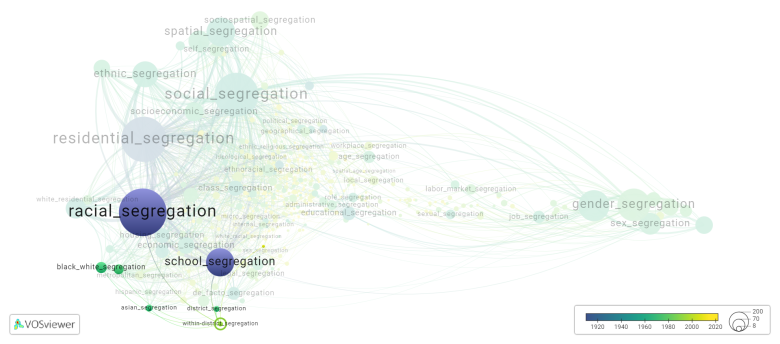Within-district segregation
Date and country of first publication[1]
2000
United States
Definition
Within district segregation refers to the segregation that occurs within a specific geographical district or area. This type of segregation can manifest in various ways, such as segregated housing patterns, segregated schools, and segregated social spaces.
One common form of within district segregation is residential segregation, where different racial or ethnic groups are concentrated in separate neighborhoods or residential areas. This segregation can be the result of various factors, including historical patterns of discrimination, economic disparities, and institutional practices such as redlining.
Within district segregation can also be seen in the context of education. In many districts, schools are segregated along racial and socioeconomic lines, with certain schools having a majority of students from one racial or income group. This can lead to unequal access to resources and opportunities, exacerbating educational disparities.
Further, within district segregation can result in segregated social spaces, such as parks, recreational facilities, and community centers. These spaces may be predominantly used by specific racial or ethnic groups, leading to limited interaction and social integration between different communities.
Overall, within district segregation contributes to the perpetuation of inequalities and can have negative social, economic, and educational impacts on marginalized communities. Efforts to address within district segregation often involve policies and initiatives aimed at promoting diversity, inclusion, and equitable access to resources and opportunities for all residents within a district.
Synonyms
The following terms are synonymous with within-district segregation:
within district segregation.
References and literature addressing this segregation form under these synonymous terms can be found below.
See also
Related segregation forms
Within-district segregation is frequently discussed in the literature with the following segregation forms:
school segregation, racial segregation, multischool racial segregation, metropolitan school segregation, metropolitan segregation, district segregation, suburban school segregation, suburban segregation, black segregation, asian segregation, residential segregation, public school segregation, black white segregation, socioeconomic segregation

This visualization is based on the study The Multidisciplinary Landscape of Segregation Research.
For the complete network of interrelated segregation forms, please refer to:
References
Notes
- ↑ Date and country of first publication as informed by the Scopus database (December 2023).
At its current state, this definition has been generated by a Large Language Model (LLM) so far without review by an independent researcher or a member of the curating team of segregation experts that keep the Segregation Wiki online. While we strive for accuracy, we cannot guarantee its reliability, completeness and timeliness. Please use this content with caution and verify information as needed. Also, feel free to improve on the definition as you see fit, including the use of references and other informational resources. We value your input in enhancing the quality and accuracy of the definitions of segregation forms collectively offered in the Segregation Wiki ©.
Within-district segregation appears in the following literature
Reardon S.F., Yun J.T., Eitle T.M. (2). The changing structure of school segregation: Measurement and evidence of multiracial metropolitan area school segregation, 1989 1995. Demography, 37(3), 351-364. Duke University Press.https://doi.org/10.2307/2648047
Reardon S.F., Yun J.T. (2001). Suburban racial change and suburban school segregation, 1987 95. Sociology of Education, 74(2), 79-101. American Sociological Association.https://doi.org/10.2307/2673164
McCulloch A. (2007). The changing structure of ethnic diversity and segregation in England, 1991 2001. Environment and Planning A, 39(4), 909-927. https://doi.org/10.1068/a37349
Eitle D., Eitle T.M. (201). Public school segregation and juvenile violent crime arrests in metropolitan areas. Sociological Quarterly, 51(3), 436-459. https://doi.org/10.1111/j.1533-8525.2010.01181.x
Finnigan K.S., Holme J.J., Orfield M., Luce T., Diem S., Mattheis A., Hylton N.D. (2015). Regional Educational Policy Analysis: Rochester, Omaha, and Minneapolis’ Inter District Arrangements. Educational Policy, 29(5), 780-814. SAGE Publications Inc..https://doi.org/10.1177/0895904813518102
Davis T., Bhatt R., Schwarz K. (2015). School segregation in the era of accountability. Social Currents, 2(3), 239-259. SAGE Publications Inc..https://doi.org/10.1177/2329496515589852
Marcotte D.E., Dalane K. (2019). Socioeconomic Segregation and School Choice in American Public Schools. Educational Researcher, 48(8), 493-503. SAGE Publications Inc..https://doi.org/10.3102/0013189X19879714
